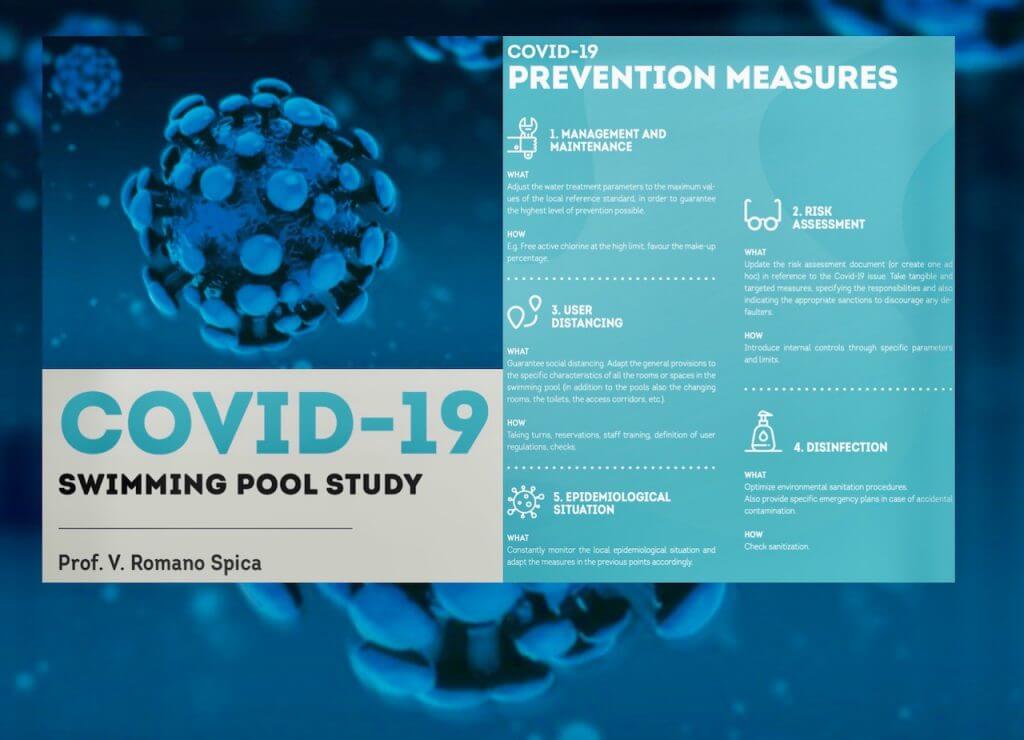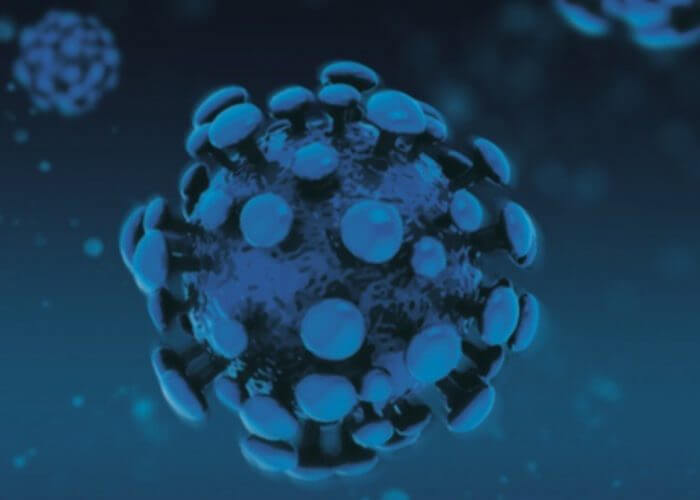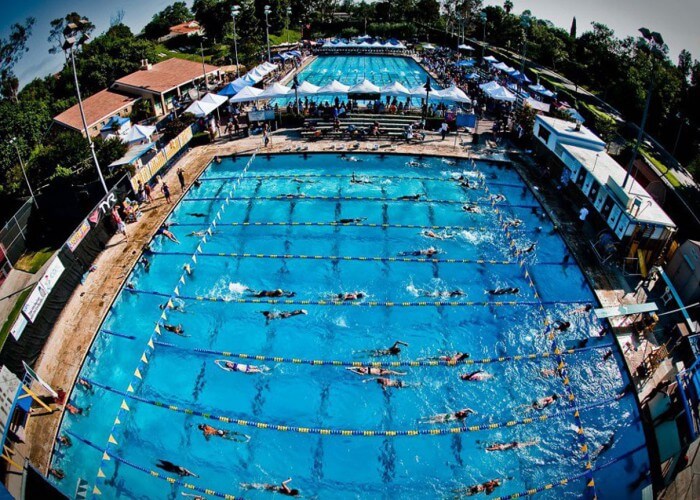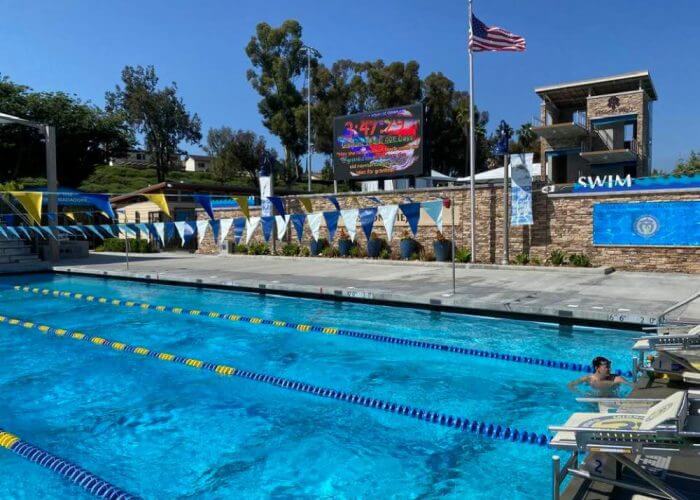Swimming Pool Safety In Focus As Hygiene Expert Professor Spica Tests Revival Waters With Us

Swimming Pool Safety: Swimming World reported of late on the “Covid-19 Swimming Pool Study“ by Vincenzo Spica, Professor of Public Health at the Università degli Studi di Roma “Foro Italico”, at a time of intensive research into the nature of the novel coronavirus at the heart of a global pandemic. The study is a work in progress. Craig Lord caught up with Prof. Spica to talk through some of the issues that pool operators and users are pondering as they plan their returns to the water as part of lockdown easing measures.
We talked in a week that witnessed much-criticised Memorial Day scenes from the United States, like that posted in a social-media video showing a crammed party pool at Lake of the Ozarks.
Such scenes are many leagues away from the safety measures being proposed and planned and already enacted at training pools used by elite swimmers around the world. Even so, many pools remain closed, summer camps, meets and programs postponed or cancelled altogether and swim club activities curtailed, at the lowest, for the foreseeable future in many nations.
Prof. Spica is among experts that say swimming pools could be among the safest places in sport as sport is revived after COVID-19 lockdown – but conditions apply. While he is optimistic that swimming can get back and pools can reopen, he also notes that many long-established habits and practices in the pool and its environment must be dropped for the sake of athletes, practitioners – and public – health and safety.
In the first report on our talk, we invite him on a flight to survey the scene of a typical training day at a pool in 2019 – and then return to the same spot in 2020. Then we invite him to play Spot the Difference.
Hover Over The Pool … What Do We See?
 Hop into the swimming World helicopter, Professor Spica. We’re off to hover over a busy pool on an average club training day sometime in summer 2019.
Hop into the swimming World helicopter, Professor Spica. We’re off to hover over a busy pool on an average club training day sometime in summer 2019.
As we peer down, we see a 50m pool divided across in multiple 25m lanes, 8 swimmers per lane.
At the end of each lane, there’s a mountain of equipment: flippers, paddles, pull buoys, drink bottles, asthma sprays, spare goggles and caps, pool shoes and waterproof bags. A little distance off, there’s a bench covered in a pile of towels and robes.
The swimmers are in the water, all those in half the lanes are at the wall, taking in what the coaches are telling them about the next set, how it should be done, what rest interval to take and so on and so forth.
Three kids have asked to use the bathroom and are scuttling off across the deck towards the changing room. Two swimmers are asked to hop out, write something on the board, which stands next to a table on which we see a large number of coloured chalks, pens, half-consumed cups of coffee, a writing pad, several stop watches. There’s laughter, several high fives. It looks like they’re having fun in the midst of the hard work.
In the compact stand just back from the deck, 20 or so parents sit chatting, reading, watching and waiting.
Hold tight, Professor Spica. Our chopper is about to zip through a time warp and ink an instant we find ourselves hovering over the same pool at a time of COVID-19 as planners prepare a revival of swimming. In the car park below, we see a small number of elite swimmers preparing to stage their entry into the water. Club night with hundreds of swimmers in three waves is a dream for a further time warp later this year, next year or sometime when, depending on where the COVID-19 pandemic goes next.
As you peer down on the scene, Prof. Spica, what do you see and what do you want us to see?
“So, from the helicopter, we see a very nicely cleaned swimming pool, as it should be, full of people and activity. Now, this somehow has to change. In our talk you highlighted two issues: one is related to the people one is related to the objects.
“On the people, we have to say that children and their grandparents are a different use of the pool than Federica Pellegrini training. It is much, much, much easier to manage the situation of a pool for elite athletes than it is for recreational uses.”
In between there are clubs with several swimmers per lane and a lot more people than an elite-level practice involving a couple of swimmers per lane at most. Where does that fit? Says Prof. Spica:
“That is a situation that even if it was a restaurant, it could not be allowed. That [swim clubs of many swimmers in the pool at once] is not a specific problem of a pool: people must also understand that that scenario is not a question specifically for the swimming pool.
“It’s more a matter about the number of people there and the social distancing required. But this doesn’t mean that we do not allow children and grandparents in the pool. It is a question of finding a solution to reduce the risks.”
Distancing and control on numbers is essential if the environment around a pool is to be as safe as the water itself, he suggests before we return briefly to the 2019 pool and a session where 8 kids are listening to the coach asking them to put paddles on and pull buoys between their legs. A couple of the kids change the goggles, a couple have a drink, one asks a friend if they can share because they forgot their bottle, another takes a puff of an asthma spray before casting back into the heap of equipment on deck.
Back to our 2020 pool, and Prof. Spica is frowning as he says:
“The question of the equipment is a problem, so far, because in recent weeks it came out that this virus is not only transferred from a sick person to a healthy person through droplets but also by hands and touching an object. And then, studies have shown that it can survive some time on plastics and metals, wood and different materials, paper, and it can even linger in the air for a certain period. Contamination through saliva and mucus is possible.
“The question is how do you disinfect these tools because they are made of different materials and you cannot use the same product for all of them. There is a risk and it can certainly be a problem. So, the idea is to allow only personal tools and avoid that mountain of equipment we see from the helicopter.
“In that scenario I see at least two things to focus on:
- “First, the goggles: the virus can be transmitted through the eyes. So to exchange goggles for a second pair that have been on the poolside is not good and should be avoided. And to use the goggles of another person – don’t do it. There should be no sharing of equipment and especially not of that kind, like goggles.
- “So, personal stuff is what has to happen with equipment and each person has to take care of the disinfecting of that equipment.”
- Second thing, In a leisure setting, we often see rubber or plastic balls at the edge of the swimming pool. We cannot do what we used to do before, that is between friends throwing the ball between people. That cannot be done for now.”
The implications for water polo are clear: as with all elite sports settings, regular testing of athletes and cleaning of equipment is likely to have to be a part of their regime for a while. If it is easy to see some forms of training undertaken, matches seem a fair way off yet in what is clearly a contact sport.
I relate the scenario at Mission Viejo as described by coach Mark Schubert, who wrote a safety plan and submitted it to the local authorities, which happen to be led by one of his old charges, Mayor Brian Goodell.

Mission Viejo 2017 – Photo Courtesy: Mission Viejo Nadadores
The plan involved one swimmer per lane; swimmers entering the water at 5-minute intervals; all being responsible for their personal equipment; no sharing; no changing rooms; come ready, get showered at home.
Mission Viejo’s moves prompted others to call for their own pools to be opened. In the mix, however, were cross to go way beyond the control of numbers and safety measures in place at Mission Viejo.

Mission Viejo – Photo Courtesy: Mark Schubert
So, are those the kind of controls necessary? Prof. Spica nods and says:
“Yes. Exactly – and then to note [the need] to reduce the use of the changing room. If you arrive ready to go into the water, that is one solution [It may not work everywhere]. In some cases, it could be that you reduce even half the number of times anyone needs to use the changing rooms because some facilities have very good changing-room conditions, with larger spaces that are easily managed, others not. Solutions have to be considered with such things, in local context.
“We had a very nice discussion with colleagues from different countries and it was very, very good to exchange ideas. What I saw was that the approach to the pool is very different from country to country, even from one club to another, one pool to another. So, certain things that, for example, we have pretty well established in Italy may not be found in other countries. It is important to try to adapt to the situation of that country and the regulations that apply there, obviously, but also taking into account the specific [pool] plant.
Personal Hygiene In The Swimming Pool
 There are good reasons why personal hygiene counts in pools, so would he agree that the cleaner the swimmer arrives in the water, the better?
There are good reasons why personal hygiene counts in pools, so would he agree that the cleaner the swimmer arrives in the water, the better?
“Yes – and not because you’re covered in COVID! But because you are covered in microorganisms, which are good for us because they are part of our skin microbiotics. There are billions of microorganisms on us, in the hair and other parts of the body. So, if we don’t shower, we put all this material into the swimming pool.
“Is it dangerous? No, it’s not dangerous – but there is a problem. All that organic material will stop the activity of chlorine. If you arrive clean, then all the available chlorine will go to work on the virus, if there is one. So, it is important to keep the water in the best condition it can be in. And everybody should participate at all times in all this good management of the water.”
Fecal material is a serious issue, particularly for learn-to-swim programs in which young children have accidents. As every pool owner knows, one accident means a closed pool. COVID-19 makes that all the more important. Chlorine does not work at all well – or even at all – when a virus is lurking in organic material. Says Prof. Spica:
“As the WHO shows explicitly in the guidelines, accidental faecal release must be taken very seriously. When that happens we cannot behave like nothing happened. The pool has to be cleared immediately. That had to happen before COVID arrived but now it is even more important. This should be very clear. We know that where the virus is present, we have a synergy situation: a high quantity of virus may be present if the person is infected; we have inactivation of the chlorine due to the presence of the organic material.”
There are several procedures to deal with this and they are already well known.”
While peeing in the pool is as old as pools, it is a problem: urine itself is sterile but it’s degradation products may cause asthma.
On the matter of how many people to have in a pool at one time, Prof. Spica notes the various plans he’s see for factoring in distance, including use of structural divisions between lanes, and says:
“What is important is that, one way or another, you ensure good distancing between people.”
From One Swimming Pool To Another
 Is Covid-19 something that requires swimming pool operators to take extra precautions with air circulation and other aspects of pool infrastructure? Says Prof. Spica:
Is Covid-19 something that requires swimming pool operators to take extra precautions with air circulation and other aspects of pool infrastructure? Says Prof. Spica:
“Regarding circulation, the main point for water as well as air is replacement, as much as possible to allow fresh air and fresh water. This is expensive, especially where the weather is not like it is in the south of Italy or the south of Europe. In many places they have to heat the air and heat the water.
This issue of circulation is important because there is a dilution effect in the pool regarding the concentration of all the contaminants.”
“Regarding the air, another important issue – one that has been studied, also in some scientific papers from the Chinese when they researched how COVID can be transmitted from one person to another in indoor environments – is the flow of the air. So if it is important to avoid horizontal flows of air because a person can cough or somehow emit the microorganism and then it can be carried far away to another person.
This is the case reported in scientific literature of a restaurant where there was an air conditioner. It moved the air all round all the people. This is the same thing that was reported to have happened in some studies made on airplanes, where some air flows could be seen to have carried the virus from the infected person to others.
“Those studies tell us to keep in mind the importance of the direction of air flow. We should avoid the horizontal movement of droplets and instead allow as much as possible the downward movement of air.”
Lifeguards
 In the welter of talk about frustrated swimmers, parents eager to get kids back to swimming pools and coaches who want and need to return to work, scant mention is made of lifeguards.
In the welter of talk about frustrated swimmers, parents eager to get kids back to swimming pools and coaches who want and need to return to work, scant mention is made of lifeguards.
Prof. Spica notes their roles as essential workers:
“Another important feature of the pool during COVID is the lifeguards. They should be educated in their additional role as inspector – but not in a negative way but in a positive way: they should be the ones to educate the users, reading them of the safe practices. They should protect each user and ensure that the user’s behaviour respects all the other users. I think lifeguards can play an important role in that.”
How about the lifeguard should an accident happen? What happens with distancing? Says Prof Spica:
“There are several protection devices that can be considered. They are the same, essentially, as those used, for example, by policemen or other forces. There is nothing new there: they can use what is already available.
“But in any case, the COVID risk becomes a secondary issue because there is a priority issue, which is to save the life of the person in trouble. So, it’s important to think in terms of prevention of COVID but also in terms of emergency. That would be an emergency. It’s rare but you have to be prepared, to have all the skills – and now you have to train the person to think ‘COVID’. That’s the kind of risk that trained people are already aware of, though other risks, including other infectious diseases. They had to be prepared for that, even before COVID.”
In the next part of our talk with Prof. Spica we look in a little more detail at the two key zones of a pool: the water and its environs and after that we’ll ask ‘what does a return to swimming and swimming training look like?’




Thank you for this follow up with Prof. Spica, Craig Lord!
I began AAU swimming 50+ years ago, teaching lessons and coaching USSwimming 42 years ago. Presently, as a private swim instructor, I teach because I have a passion for swimming and love and respect for children. Health comes before children learning to swim and my resuming teaching six days/week to earn a living.
I am frustrated by many eager to get back to swimming in community pools reading the CDC statement to suit their desires, so I’ve added and pointed to the areas where particularly weak wording indicates it is NOT YET safe to dive back in: “there is no evidence (YET) that COVID-19 can be spread to humans through the use of pools and hot tubs. Proper operation, maintenance, and disinfection (e.g., with chlorine and bromine) of pools and hot tubs –>should remove or inactivate the virus<– that causes COVID-19."
I've read numerous scientific articles to do with chlorine and SARS-CoV-2 which clearly state there is more to learn before it can be deemed safe to go back in the water, so to speak.
Unwilling to put myself and my swim lesson clients (and our family and friends) at risk, I will not work in community pools until The Evidence is clear and conclusive . . . I don't wish to be The Evidence and I hope those who are will luck out and not contract and spread Covid-19.
Keep these science based findings coming!